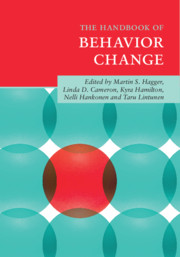Book contents
- The Handbook of Behavior Change
- The Handbook of Behavior Change
- Copyright page
- Dedication
- Contents
- Figures
- Tables
- Sidebars
- Contributors
- 1 Changing Behavior: A Theory- and Evidence-Based Approach
- Part I Theory and Behavior Change
- 2 Changing Behavior Using the Theory of Planned Behavior
- 3 Changing Behavior Using Social Cognitive Theory
- 4 Changing Behavior Using the Health Belief Model and Protection Motivation Theory
- 5 Changing Behavior Using the Common-Sense Model of Self-Regulation
- 6 Changing Behavior Using the Model of Action Phases
- 7 Changing Behavior Using the Health Action Process Approach
- 8 Changing Behavior Using Self-Determination Theory
- 9 Changing Behavior Using Control Theory
- 10 Changing Behavior Using the Transtheoretical Model
- 11 Changing Behavior Using Integrative Self-Control Theory
- 12 Changing Behavior Using the Reflective-Impulsive Model
- 13 Changing Behavior Using Habit Theory
- 14 Changing Behavior by Changing Environments
- 15 Changing Behavior Using Integrated Theories
- 16 Changing Behavior Using Social Identity Processes
- 17 Changing Behavior Using Ecological Models
- 18 Changing Behavior Using Theories at the Interpersonal, Organizational, Community, and Societal Levels
- Part II Methods and Processes of Behavior Change: Intervention Development, Application, and Translation
- Part III Behavior Change Interventions: Practical Guides to Behavior Change
- Index
- References
12 - Changing Behavior Using the Reflective-Impulsive Model
from Part I - Theory and Behavior Change
Published online by Cambridge University Press: 04 July 2020
- The Handbook of Behavior Change
- The Handbook of Behavior Change
- Copyright page
- Dedication
- Contents
- Figures
- Tables
- Sidebars
- Contributors
- 1 Changing Behavior: A Theory- and Evidence-Based Approach
- Part I Theory and Behavior Change
- 2 Changing Behavior Using the Theory of Planned Behavior
- 3 Changing Behavior Using Social Cognitive Theory
- 4 Changing Behavior Using the Health Belief Model and Protection Motivation Theory
- 5 Changing Behavior Using the Common-Sense Model of Self-Regulation
- 6 Changing Behavior Using the Model of Action Phases
- 7 Changing Behavior Using the Health Action Process Approach
- 8 Changing Behavior Using Self-Determination Theory
- 9 Changing Behavior Using Control Theory
- 10 Changing Behavior Using the Transtheoretical Model
- 11 Changing Behavior Using Integrative Self-Control Theory
- 12 Changing Behavior Using the Reflective-Impulsive Model
- 13 Changing Behavior Using Habit Theory
- 14 Changing Behavior by Changing Environments
- 15 Changing Behavior Using Integrated Theories
- 16 Changing Behavior Using Social Identity Processes
- 17 Changing Behavior Using Ecological Models
- 18 Changing Behavior Using Theories at the Interpersonal, Organizational, Community, and Societal Levels
- Part II Methods and Processes of Behavior Change: Intervention Development, Application, and Translation
- Part III Behavior Change Interventions: Practical Guides to Behavior Change
- Index
- References
Summary
This chapter describes the reflective-impulsive model (RIM) and elaborates those features that are functionally important for behavioral interventions. The RIM explains behavior as being controlled by two interacting systems, which each follow a distinct set of operating principles. The reflective system operates based on propositional representations and syllogistic reasoning and affects behavior via goal-driven decisions mediated via a process of intending, which activates goal-congruent behavioral schemata until the goal associated with the decision is reached. The impulsive system operates based on associative representations, with behavioral schemata serving as a pathway to behavior that is also modulated by the reflective system. Within the impulsive system, motivational orientations of approach-avoidance as well as homeostatic dysregulation modulate the accessibility of representations in the impulsive system and, thereby, its reactivity to stimuli. The impulsive system operates at a higher degree of automaticity compared to the reflective system but is, at the same time, constrained in its processing capabilities such as being unable to process negations. Interventions based on the RIM typically aim to change evaluative associations, to prevent deprivation-driven hyper-reactivity to stimuli, and to change approach/avoidance tendencies via computer-based training. Although there are several demonstrations of their effectiveness, there is still ongoing debate about the mediators and boundary conditions of these interventions.
Keywords
Information
- Type
- Chapter
- Information
- The Handbook of Behavior Change , pp. 164 - 177Publisher: Cambridge University PressPrint publication year: 2020
